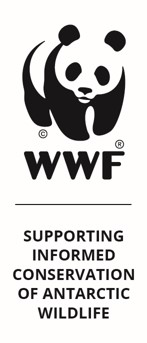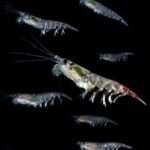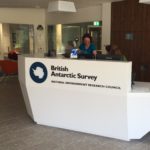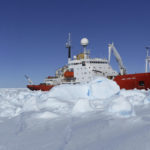KRILLBASE is a data rescue and compilation project which aims to improve the availability of information on two of the Southern Ocean’s most important zooplankton taxa: Antarctic krill (Euphausia superba) and salps (Family Salpidae).
In 2016, the project released a database of information from 12,880 scientific net samples, collected between 1926 and 2016 by scientists from ten countries. These data, on the density (number under 1m2 of sea surface) of Antarctic krill and salps, with associated environmental data and sampling information provide a resource for analysing the distribution and abundance of these taxa throughout the Southern Ocean.
Why Antarctic krill?
The shrimp-like crustacean Antarctic krill (Euphausia superba) if often described a key species in the Southern Ocean, because of its abundance (estimated at around 780 trillion (7.8 * 1014) individuals, excluding eggs and larvae), its wide distribution (it is found at all latitudes of the Southern Ocean and at all depths) and its importance as prey to a wide range of predators (from brittle stars on the seabed to great whales). The role of Antarctic krill as a major prey species and a grazer of phytoplankton mean that it has a profound influence on foodwebs and biogeochemical cycles. It is also caught by a fishery, which must be managed to prevent disruption of the ecosystem. Information about Antarctic krill distribution and dynamics is important for the development of sustainable fishery management and conservation policy (e.g., identifying suitable Marine Protected Areas and assessing the dynamics of fished stocks).
Why salps?
Although a similar size to Antarctic krill, salps look very different. They are jelly-like filter feeders and have alternating generations of solitary individuals followed by long chains of connected individuals. They can form dense “blooms” in some years and are important members of the Southern Ocean ecosystem. Some scientists have suggested that salps thrive in conditions which are detrimental for Antarctic krill and may become more abundant as a result of climate change. Thus, information on salps provides a more complete picture of the changes that affect Antarctic krill.
A brief history of KRILLBASE
In the 1990s several countries began monitoring programmes in selected parts of the Southern Ocean, sampling the same area every year to assess changes in the ecosystem. In the same decade, the founders of KRILLBASE recognised that combining these data, and adding historical data that pre-dated the monitoring programmes, would provide more information than any individual programme could. They identified masses of data on Antarctic krill and salps. However these data were mainly confined to dusty archives, faded logbooks, old disks or databases.
Compiling the data is a mammoth task which is progressing with the cooperation of scientists from the US, UK, Germany, Ukraine, Australia, South Africa, Japan, Poland, Spain, Norway and Chile. Indeed, new data are collected every year, and participants in the project intend to produce new updates in the future.
Along the way the project has produced a series of papers that have updated our understanding of Antarctic krill, and the ecosystem that depends on them.
In 2016, with the support of WWF, the project released the first publicly accessible compilation of circumpolar data on krill and salp density. See the “Data” tab for access to these data and information on their use.
To improve the availability of information on two of the Southern Ocean’s most important zooplankton taxa: Antarctic krill (Euphausia superba) and salps (Family Salpidae).
Project contributors
KRILLBASE is an international project involving collaborators from eleven countries and compiling data collected by research programmes in the USA, UK, Germany, former Soviet Union, Australia, South Africa, Japan, Poland, Spain and Norway. It was founded by Angus Atkinson, Evgeny Pakhomov and Volker Siegel in the late 1990s. The full list of contributors is:
| A. Atkinson |
Plymouth Marine Laboratory |
UK |
| R. Anadon |
University of Oviedo |
Spain |
| S. Chiba |
Japan Agency for Marine-Earth Science and Technology |
Japan |
| K.L. Daly |
University of South Florida |
USA |
| R. Downie |
WWF |
UK |
| Fretwell P |
British Antarctic Survey |
UK |
| L Gerrish |
British Antarctic Survey |
UK |
| G.W. Hosie |
Sir Alister Hardy Foundation for Ocean Sciences |
UK |
| S.L. Hill |
British Antarctic Survey |
UK |
| M.J. Jessopp |
University College Cork |
Ireland |
| S. Kawaguchi |
Australian Antarctic Division |
Australia |
| B.A. Krafft |
Institute of Marine Research |
Norway |
| V. Loeb |
Moss Landing Marine Laboratories |
USA |
| J. Nishikawa |
Tokai University |
Japan |
| E. A. Pakhomov |
University of British Columbia |
Canada |
| H.J. Peat |
British Antarctic Survey |
UK |
| C.S Reiss |
NOAA Fisheries |
USA |
| R.M. Ross |
University of California at Santa Barbara |
USA |
| L.B. Quetin |
University of California at Santa Barbara |
USA |
| K. Schmidt |
Sir Alister Hardy Foundation for Ocean Sciences |
UK |
| D.K Steinberg |
Virginia Institute of Marine Science |
USA |
| V. Siegel |
Thünen Institute of Sea Fisheries |
Germany |
| R.C. Subramaniam |
University of Tasmania |
Australia |
| G.A. Tarling |
British Antarctic Survey |
UK |
| P. Ward |
British Antarctic Survey (retired) |
UK |
21 February, 2019
Large krill swarms in the Southern Ocean could help remove additional carbon from the atmosphere, in a way that is currently ‘hidden’ in global models. The new study is published …
21 January, 2019
The population of Antarctic krill, the favourite food of many whales, penguins, fish and seals, shifted southward during a recent period of warming in their key habitat, new research shows. …
The publication of the KRILLBASE data was funded by WWF.
The project aims to compile a range of data on krill and salps in the Southern Ocean. The main data product is the database of densities (number under 1m2 of sea surface) spanning 1926 to 2016.
These data were collected using a variety of net sampling methods. Krill densities are available both as observed densities and as standardised densities (standardised to a single net sampling method) to allow comparison of data collected using different methods.
It is important to be aware of the caveats associated with these data. The following paper describes the dataset and the caveats and limitations on its use has been submitted to a journal:
Atkinson A, Hill SL, Pakhomov E, Siegel V, Anadon R, Chiba S, Daly KL, Downie R, Fielding S, Fretwell P, Gerrish L, Hosie GW, Jessopp MJ, Kawaguchi S, Krafft BA, Loeb V, Nishikawa J, Peat HJ, Reiss CS, Ross RM, Langdon B. Quetin, Schmidt K, Steinberg DK, Subramaniam RC, Tarling GA, Ward P (2017) KRILLBASE: a circumpolar database of Antarctic krill and salp numerical densities, 1926–2016. Earth Syst. Sci. Data, 9: 193-2107 [Link]
The main caveats are that:
- Sampling method varies between areas and between years. Consider the potential influence of sampling variability on results.
- Some nets do not sample the upper layers of the water column. It might be appropriate to exclude such data.
- The accuracy of date and time of day information varies between records. This can affect the standardised results.
- Nets are likely to under-sample mobile animals such as krill. The data therefore provide a relative index of krill density.
The DOI for dataset is doi.org/brg8 (long form: doi:10.5285/8b00a915-94e3-4a04-a903-dd4956346439).
These data have been collected by research programmes in ten countries and made available by a large group of project participants. These participants have also contributed to the submitted data paper which, when published, will form a citable description of the data.
Follow this link to the data.
The paper by Atkinson et al (2017) should be cited when analyses of these data are published.

Science, business and operational planning
One of the world's most advanced polar research vessels



